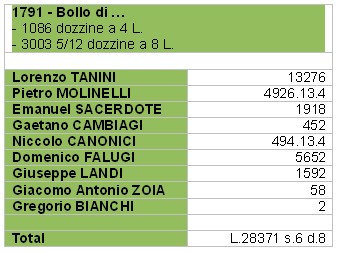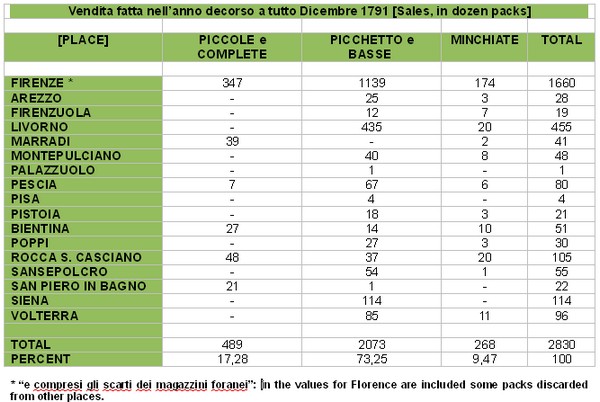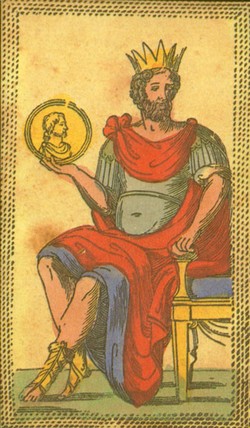Introduction
Many years ago I began a research in the Archivio di Stato di Firenze (ASF) on the production of playing cards in the Grand Duchy of Tuscany. Unfortunately, the data that I could find were too scattered and I was not able to obtain a coherent framework: for some years there were more data than necessary, followed by long intervals with no data at all. It thus happened that this research was interrupted before it could provide useful results for any interested people.
Now, I have somewhat changed my mind and am satisfied with even small pieces of information, in the hope that the readers will then be able to build a reasonable reconstruction of the actual situation by themselves. A note of this kind can already be found here, for the years 1839 and 1841.(1) Let us go on, with some interesting data for the year 1791.
The register
The book that I have examined is a large format one, which consists of several yearly registers bound together and also some parts loosely inserted.(2) My description here is only derived from the first register, corresponding to the year 1791, a documented report compiled at the end of the year.
In particular, I found there two lists of special interest; there are more of them, involving employees and their salaries, and similar matters, which I have neglected here. Further data can be found in the following registers of the book, with records up to 1807, especially devoted to stamped paper.
Cardmakers and production
The first useful list is that of cardmakers, who were active at the time, including the amount of cards that they produced. Unfortunately, the production of the various kinds of playing cards is not recorded here, but only the total money amount paid as stamp duty. Of course, this amount is directly related to the packs produced, or better to the dozen packs produced.
There were at the time five different kinds of cards admitted: Piccole, Complete, da Picchetto, Basse, Minchiate. For taxation, these five types were put together into two groups, one charged at 4 L. for a dozen packs, the other group at 8 L. The only direct information on the amount of cards produced can be read here as 1086 dozen and 3003 and 5/12 dozen packs for the two groups (supposedly, the former with Piccole and Complete, the latter with the three remaining kinds).

The total production of 1791 was near to fifty thousand packs on the whole. Of course, the relative contribution of the various makers can only be compared in a rough way: if a maker was specialised in packs taxed at 4 L. and another in packs taxed at 8 L., the same money value in the list could correspond to twice as many packs produced by the former.
In conclusion, we get the nine names of the makers active at the time and a rough classification of their relative contribution to the whole production. Should this be useful, it will not be too difficult to find further data on the individual productions of these makers for years close to this one. What I had never seen is, on the contrary, the information of the following table, of a different kind.
The distribution within the country
Here we actually get the opportunity to follow the destination of the packs produced in Florence. As for the places recorded, they correspond to towns where the administration had established a network of local bases for card trade. (By the way, two of them - Rocca S. Casciano and San Piero in Bagno - do no longer belong to Tuscany.)
Personally, I had no idea how the playing cards could be distributed among the various channels that had been established on the way to the minor towns of the country. Here we get that idea. Of course, we have to study it in a realistic way, owing to the fact that it only corresponds to a single year: it is possible that in a place where many dozen packs are recorded to have been sold in 1791, no pack at all were sold in the previous year, or in the following one.
However, we can now see how the various packs were used in Florence and far from the chief town. Of particular interest is to check the relative contribution of minchiate to the total of playing cards: a quantity of about 10 per cent is probably more than we had expected for this time, relatively late for this traditional game.
One may note that there is a discrepancy between the packs produced in Florence and those sold in Tuscany in the same year (49133 to 33960, if I am right). An exact correspondence could not be expected, and we have no detail about how many packs were exported (or imported, as we know for instance for some minchiate coming from Bologna), but I would have imagined a smaller difference.
Vendita fatta nell’anno decorso a tutto Dicembre 1791 [Sales, in dozen packs]

Conclusion
I have reported new information on the production and sale of playing cards in Tuscany in the year 1791. We learn in particular that the amount of minchiate sold in 1791 was about 10% of the total packs, and that about one third of them were sold far from the chief town. Whereas further data on card production can be found in the public registers of the time, information on the distribution of the packs through the country, as provided here, is very hard to discover in the archives.
Footnotes:
(1) Franco Pratesi: Florentine Card Production in about 1840
(2) ASF, Ufficio del bollo e marchio di Firenze, 16.
Side bar pictures and text added by Lothar Teikemeier
|

King of Coins in Minchiate game
The perhaps most interesting observation in this article is, that the game Minchiate seems to have had in the year 1791 c. 10 percent of the playing card market.
In the article to playing card production in Florence in 1840 the Minchiate part had only about 1 percent (however, both values might be not totally reliable).
"There is no game on the cards, of which I have any knowledge, that requires closer attention, a more ready talent for figures, or greater exercise of the memory, than this of Minchiate. It is held in high estimation among the fashionable circles in Tuscany, where almost everybody exclaims, in the language of the treatise, "è senza dubbio il più nobili di tutti i Giochi che siensi mai potuti inventare colle carte."
(from "Account of the Italian Game of Minchiate ...", by Robert Smith, 1803).
The author had bought his game "a few years ago", so his enthusiasm and the remarks of the contemporary players in Florence might well mirror the situation around 1791.
Minchiate had more or less lost all public interests in c. 1930 in Genova under the name of Gallenini, the Florentine version had finished at begin of XX century. The Sicilian Minchiate version with the name Gallerini is said to have been gone at end of XVIII century.
According Dummett and McLeod (p. 316) in Tuscan legislation about tax stamps the name Germini was used between 1636-1686 and the name Minchiate between 1696-1780.
|
|


